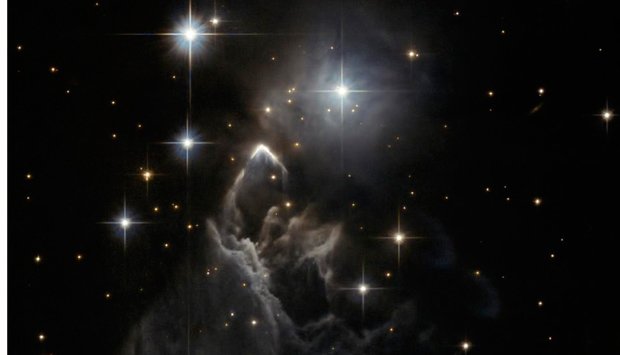“Ghost” nebula puzzles astronomers

ASTRONOMERS HAVE BEEN LEFT puzzled over the origin of light illuminating the boomerang-shaped arc in a mysterious nebula, which has been photographed floating like a ghostly apparition in space.
NASA released the image of the reflection nebula known as Ira’s Ghost last week, after it was photographed by the Hubble Telescope. Ira’s Ghost is located within the Milky Way’s Taurus constellation, and was snapped by Hubble as a ‘bonus target’ in addition to its usual tasks.
Hubble’s photographs are both spectacular and spectral, and show the tip of one of Ira’s Ghost’s highest clouds with a boomerang-shaped halo. Dr Greg Madsen, a space scientist from the University of Sydney, says the photographs are particularly interesting for scientists because they allow us to distinguish Ira’s Ghost’s physical properties, inferring its temperature and mass, “and get a good picture of what’s going on.”
LAUNCH OUR GALLERY OF NEBULAE IMAGES
Star nurseries
Nebulae are clouds of gas and dust particles floating in space that are the Universe’s “nurseries, where stars are born,” says Greg.
Nebulae usually appear in one of two forms: either those that emit their own light and or those that reflect nearby light. An emission nebula’s light source comes from a hot star embeded inside the cloud, which energises its gas atoms. A reflection nebula, on the other hand, doesn’t emit any optical light of its own – it does emit infrared light – and typically shines because an internal source of light illuminates its dust. NASA likens the effect to fog around a street lamp.
What makes Ira’s Ghost – a reflection nebula – so unusual, says NASA, is there is no apparent light source to account for the bright boomerang-shaped arc at its top, says Greg. Puzzled scientists searching for a solution to this mystery have suggested the bright arc may be illuminated by a star born deep inside the nebula, which, for some reason has high velocity.
“The interaction of [a] fast-moving star with its surroundings would naturally create the ‘swept-back’ arc you see in the image and would also explain why it is on the outskirts on the nebula,” Greg says. But such a fast-moving star is yet to be identified by scientists.
Greg says while it’s very hard for a reflection nebula to produce its own light, another possible explanation is that Ira’s Ghost is a nebula cloud moving very fast from a resulting supernova explosion. “It can gather dust and gas as it travels, resulting in it expanding quickly, creating a kind of shockwave that causes it to light itself,” he says.

